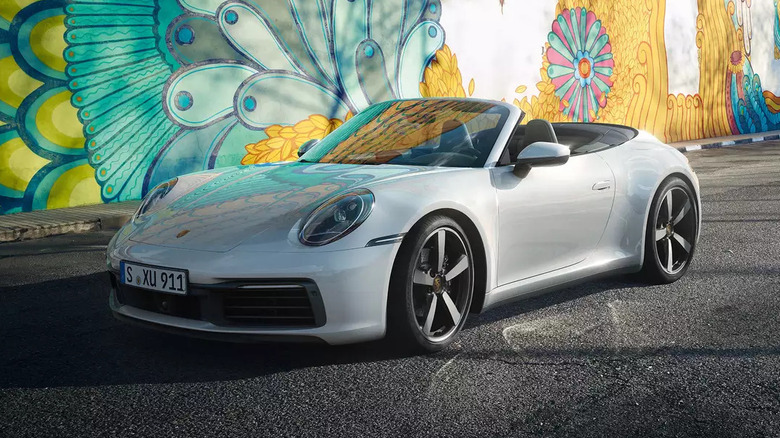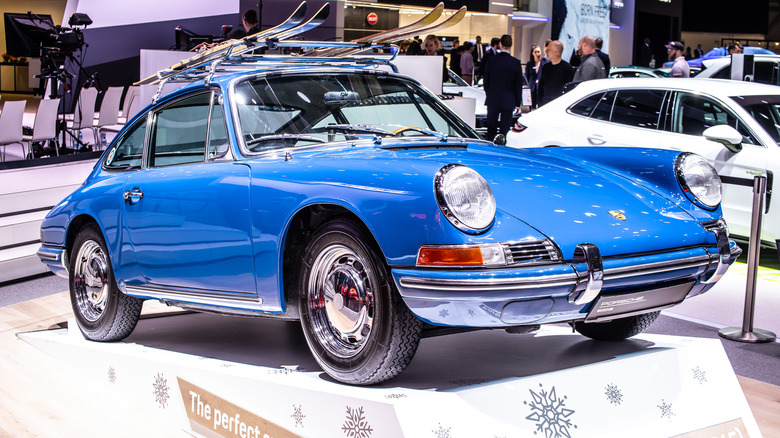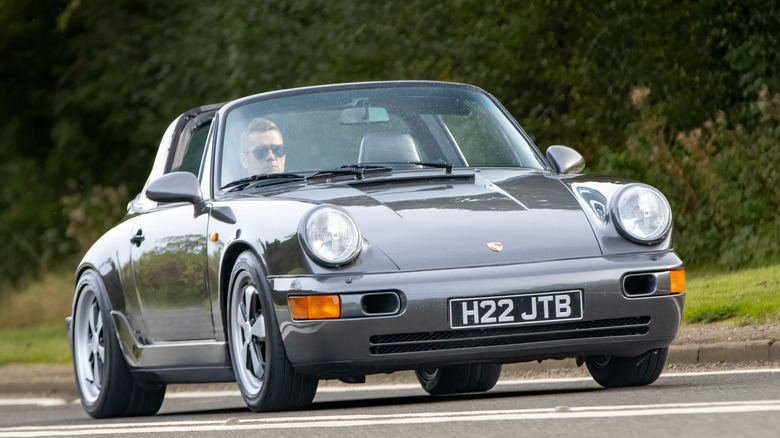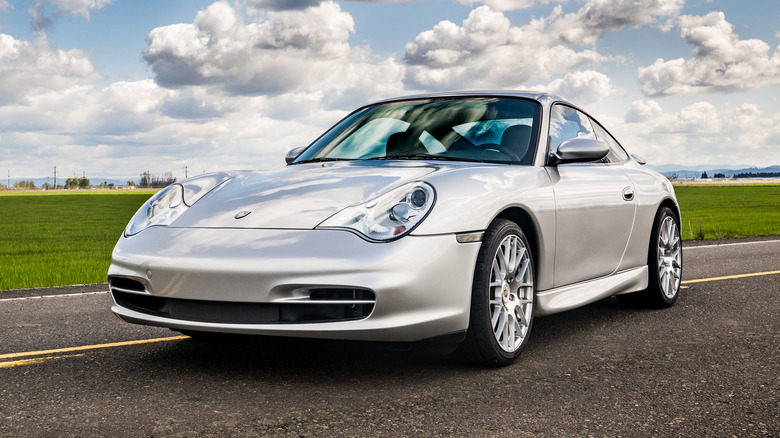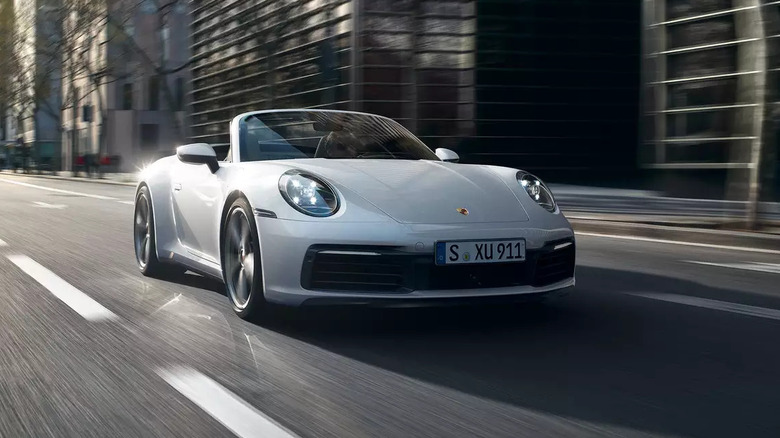Here's How The Porsche 911 Has Evolved Over 60 Years (And What's Stayed The Same)
The Porsche 911 has been a staple of the German automaker's line of vehicles for 60 years. Few sports cars have had the kind of long-lasting life that this one has, especially when you consider how consistently the car has been made over those six decades. Some cars get radical reinventions every few years to the point where the most recent model of the car only vaguely resembles the original model, but the 911 is an exception. It has been a flashy, high-powered sports car and will continue to be so.
As reported by The New York Times, it came in fifth place when it came to vote for the Car of the 20th Century, and it has won World Performance Car at the World Car Awards as recently as 2021. Not only has it had a place in the commercial marketplace, but it has been a major presence on the racing scene as well. This was especially true in the 1970s when it won the 1979 Le Mans and four straight World Sportscar Championship titles. So, what has made this car such an acclaimed hit that Porsche has taken the tactic of not fixing what isn't broken with it?
The first Porsche 911
The very first Porsche 911 back in 1964 was a two-door coupé designed by Ferdinand Alexander "Butzi" Porsche, the grandson of the company's founder. Originally, the car was meant to be called the 901, but in what is arguably one of the pettiest moves of all time, French automaker Peugeot claimed it had a patent on automobile models that featured three numbers where the middle number was a zero. Hence, it was changed to 911.
Despite the two-door car's smaller size, which measured 63.4 inches wide, 57 inches tall, and 163.9 inches long, this was set up for a two-by-two configuration for seating. The original 911 featured a 2.0-liter air-cooled, flat-six engine that could reach up to 128.5 hp. For comparison, the Porsche 356 — to which the 911 was essentially the successor — featured a 1.6-liter flat-four engine whose horsepower couldn't get higher than 94.
Three years later, Porsche started putting variations of the 911 on the market, including a targa-top semi-convertible and a higher-performance S model. The 911S bumped things up to generate 158 hp, even though the actual size of the engine didn't change. That wouldn't happen until a few years later when it introduced a 2.2-liter, and every few years after that, Porsche would introduce a larger flat-six engine until it got to the 3.3-liter for the 1979 Porsche 911 Turbo. After that, things pretty much stayed the same until 1989.
The 964 and 993
Even though the Porsche 911 has always been marketed as the 911, that is not how the company distinguishes the different evolutions behind the scenes. When the Turbo was introduced in the mid-1970s, that was technically the 930, and in 1989, the 964 hit the market. Not much had changed about the 911 after 25 years outside of what was under the hood, but this model shook things up quite a bit.
For one, this was the first time an all-wheel drive option was made available to Carrera 4 models, while the Carrera 2 versions still had the standard rear-wheel drive. According to Carfolio, both models had been upgraded to a 3.6-liter flat-six engine for 247 hp, nearly double the horsepower of the original 911 back in 1964. This update also introduced more modern elements of car operations, like power steering, to the vehicle.
From an aesthetic point of view, the shape of the 911 basically stayed the same, though the lines became a little boxier than the sleeker curves of the older models. The bumpers were also integrated into the car, rather than having that shiny metal wrap around the base of the car.
After five years, Porsche would give another update to the 911 called the 993. In terms of design, it was not all that different from the 964, though it brought back the sleeker curves while retaining the integrated bumpers.
The 996 and 997
Without question, the biggest aesthetic change for the Porsche 911 came with the 996 model, which hit the market in 1997. For over 30 years, a major visual factor for the 911 was the dual circular headlights out front. Having those lights protruding out acted as a nice counterbalance to the sloping hood between them. As the bumpers became about a decade earlier, the headlights were now fully integrated into the body of the vehicle as well, and they were no longer the perfect circles from before. They were now more of a teardrop shape and much larger.
Under the hood, not much had changed about the engine, though it had gone up to handle about 296 hp. However, this is also when Porsche moved away from air-cooled engines to water-cooled ones.
When the 997 came along in 2004, there was clearly a desire to return somewhat to the classic look of the 911. So, while the headlights were still integrated into the vehicle more seamlessly than before, there was a return to the rounder headlights of the previous generation. This model ran until 2013, and towards the end of its run, the company introduced its first 4.0-liter engine for a limited edition racing car called the 911 GT3 RS 4.0, which Porsche claims can reach a maximum of 500 hp.
Where we are now
We have had two more versions of the 911 in the last decade, the 991 and the current 992 models, and they exist as natural evolutions of what has come before. That is how Porsche has maintained the 911 for so long. The company rarely does anything radical to its tried and true formula. The basics of the design stay fundamentally the same and are adjusted to fit the modern-day trends of car making. The one time Porsche tried to make a big change to the car with the non-circular headlights, it decided to change back to the old ways almost immediately.
All Porsche has to do with the 911 is keep up with the evolution of engines and automobile technology to maintain a high level of quality. This is one of those times when a company hit it out of the park on the first try and just continued with its successful formula. Some cars get stuck in the era in which they were created, but the Porsche 911 has proved to be an evergreen vehicle, and that's why the company can make available nine different versions of the same vehicle for purchase.
